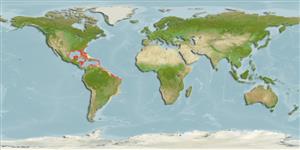Teleostei (teleosts) >
Kurtiformes (Nurseryfishes, cardinalfishes.) >
Apogonidae (Cardinalfishes) > Apogoninae
Etymology: Apogon: Greek, a = without + Greek pogon = chin, beard (Ref. 45335).
Environment: milieu / climate zone / depth range / distribution range
Ecology
Marine; reef-associated; depth range 1 - 75 m. Tropical
Western Atlantic: southern Florida in USA and Bahamas to Curaçao and Venezuela, including the Gulf of Mexico (Ref. 9626).
Size / Weight / Age
Maturity: Lm ? range ? - ? cm
Max length : 6.5 cm TL male/unsexed; (Ref. 7251)
Most common in seagrass beds, but occurs from water's edge to 75 m depth. Commonly trawled on shallow shrimp grounds.
Life cycle and mating behavior
Maturity | Reproduction | Spawning | Eggs | Fecundity | Larvae
Mouthbrooders (Ref. 240). Distinct pairing during courtship and spawning (Ref. 205).
Robins, C.R. and G.C. Ray, 1986. A field guide to Atlantic coast fishes of North America. Houghton Mifflin Company, Boston, U.S.A. 354 p. (Ref. 7251)
IUCN Red List Status (Ref. 130435: Version 2024-2)
Threat to humans
Harmless
Human uses
Tools
Special reports
Download XML
Internet sources
Estimates based on models
Preferred temperature (Ref.
123201): 22.7 - 28, mean 25.6 °C (based on 478 cells).
Phylogenetic diversity index (Ref.
82804): PD
50 = 0.5000 [Uniqueness, from 0.5 = low to 2.0 = high].
Bayesian length-weight: a=0.01096 (0.00469 - 0.02561), b=3.08 (2.90 - 3.26), in cm total length, based on LWR estimates for this Genus-body shape (Ref.
93245).
Trophic level (Ref.
69278): 3.4 ±0.45 se; based on food items.
Resilience (Ref.
120179): High, minimum population doubling time less than 15 months (Preliminary K or Fecundity.).
Fishing Vulnerability (Ref.
59153): Low vulnerability (10 of 100).
Nutrients (Ref.
124155): Calcium = 203 [119, 491] mg/100g; Iron = 1.6 [0.9, 2.8] mg/100g; Protein = 18.7 [17.4, 19.9] %; Omega3 = 0.183 [0.087, 0.392] g/100g; Selenium = 42.2 [18.0, 94.3] μg/100g; VitaminA = 109 [35, 345] μg/100g; Zinc = 2.52 [1.57, 3.77] mg/100g (wet weight);
